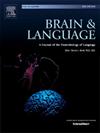Temporal dynamics of syntax and semantics during minimal hierarchical structure processing
IF 2.3
2区 心理学
Q1 AUDIOLOGY & SPEECH-LANGUAGE PATHOLOGY
引用次数: 0
Abstract
The ability to construct hierarchical structures through syntactic Merge and semantic processes is a cornerstone of human language. Despite decades of debate over serial vs. parallel interaction processing models, the temporal dynamics underlying the interaction between syntax and semantics during even minimal hierarchical structure construction remain unclear. To address this, we employed a 2 (Sequence rules: hierarchical vs. linear) × 2 (Semantics: associated vs. unassociated) design in verb-noun sequences to disentangle syntax and semantics processing. We recorded the EEG data while 48 Chinese speakers read two words successively under a one-word probe task. The results from ERP and multivariate pattern classification analysis demonstrated (1) early syntactic Merge processing, and (2) the progressively intensifying interplay between syntax and semantics, where syntactic processing establishes structure stably from the early-stage while semantic processing incrementally intensifies over time. These findings challenge traditional serial and parallel processing models by uncovering simultaneous yet distinct temporal trajectory of syntactic and semantic processing. By bridging principles of the Minimalist Program with empirical evidence, we propose a dynamic parallel interaction processing model, highlighting the distinct but interdependent roles of syntax and semantics, with syntax serving as a foundational scaffold and semantics contributing the depth and variability needed for meaningful communication.
最小层次结构处理过程中语法和语义的时间动态
通过句法合并和语义过程构建层次结构的能力是人类语言的基石。尽管关于串行与并行交互处理模型的争论已经持续了几十年,但即使是在最小层次结构构建过程中,语法和语义之间交互的时间动态仍然不清楚。为了解决这个问题,我们在动词-名词序列中采用了2(序列规则:分层vs线性)× 2(语义:关联vs非关联)设计,以理清语法和语义处理。在单词探测任务下,我们记录了48名汉语说话者连续读两个词时的脑电图数据。ERP和多变量模式分类分析的结果表明:(1)早期的句法合并处理;(2)句法和语义之间的相互作用逐渐增强,句法处理从早期开始稳定地建立结构,而语义处理随着时间的推移逐渐加强。这些发现通过揭示句法和语义处理的同时但不同的时间轨迹,挑战了传统的串行和并行处理模型。通过将极简程序的原则与经验证据相结合,我们提出了一个动态并行交互处理模型,强调语法和语义的不同但相互依存的作用,语法作为基础框架,语义为有意义的交流提供深度和可变性。
本文章由计算机程序翻译,如有差异,请以英文原文为准。
求助全文
约1分钟内获得全文
求助全文
来源期刊

Brain and Language
医学-神经科学
CiteScore
4.50
自引率
8.00%
发文量
82
审稿时长
20.5 weeks
期刊介绍:
An interdisciplinary journal, Brain and Language publishes articles that elucidate the complex relationships among language, brain, and behavior. The journal covers the large variety of modern techniques in cognitive neuroscience, including functional and structural brain imaging, electrophysiology, cellular and molecular neurobiology, genetics, lesion-based approaches, and computational modeling. All articles must relate to human language and be relevant to the understanding of its neurobiological and neurocognitive bases. Published articles in the journal are expected to have significant theoretical novelty and/or practical implications, and use perspectives and methods from psychology, linguistics, and neuroscience along with brain data and brain measures.
 求助内容:
求助内容: 应助结果提醒方式:
应助结果提醒方式:


